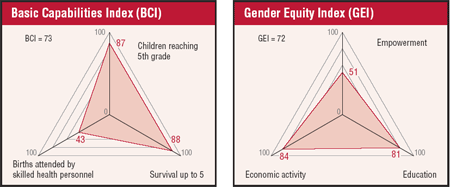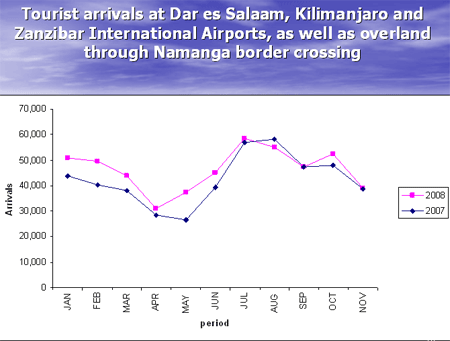Poverty reduction is endangered
Poverty reduction is endangered
SAHRiNGON (T) Chapter
Armando SwenyaMartina
M. Kabisama
Kambibi Kamgisha
Although its financial system has not yet been severely affected by the global economic crisis, the decrease in exports, remittances and aid will imperil Tanzania’s progress in eradicating poverty. Basic services, such as the provision of clean water, sanitation and health, must be extended, as well as credit and instruction to farmers. For all this, it is essential that aid is not discontinued.
 |
The Tanzanian economy depends mainly on agriculture, which accounts for about 42% of GDP.1 Average annual economic growth since 2000 has been 5.8%,2 up from 3% in the late 1990s. Although the country has undergone significant macroeconomic and structural reforms, including privatization of public companies, market liberalization and investments in key economic sectors such as mining, agriculture, tourism and telecom industries, it has a long way to go regarding poverty reduction. More than one third of the population still lives on less than USD 1 per day.3
Economic growth has not yet adequately translated into increased per capita income. The budget allocation for development programmes, including social services such as health, education and infrastructure, is minimal compared to recurrent expenditures such as salaries of public officials and management of government offices. In addition, Tanzania is heavily dependent on aid, which contributed approximately 42% of the national budget in 2007.
Impacts of the global crisis
Although the world economic crisis has had an impact on Tanzania, financial institutions have not been affected so far.4 There are several reasons for this: the country has a low level of integration into international financial markets; foreign assets cover just 11% of total commercial bank assets; and banks are licensed, regulated and supervised under national laws – i.e., not operated as branches of parent banks abroad but as independent subsidiaries. In addition, the country had a limited amount of foreign borrowing and no securities from the international banks that were affected by the crisis. The interbank cash market continues to be liquid and stable, and lending to the private sector increased by 47% in 2008.5
However, the Tanzanian economy faces a big challenge since the income from key exports has decreased due to declining demand and lower prices. For example, in January 2009, 138,011 bales of cotton (a quarter of the total output for the 2008/09 season) were piled up in ginneries due to lack of orders. In June 2008 it was expected that cotton farmers would earn TZS 300 (USD 0.23) per kg, but prices in the world market fell as low as TZS 200 (USD 0.16) per kg. Tourism and mining may also feel the impact. Tourism contributes 17.2% of GDP, second in importance only to agriculture. Tanzania received 719,031 tourists during the financial year 2006/07 and money accrued was about USD 1 billion. Many tourists have already cancelled bookings, and it is estimated that earnings may decline up to 20%. Mining may be affected due to the reduction in foreign direct investment (FDI).
 |
Since 2000 the country has been implementing poverty reduction strategies, supported by a comprehensive and strong National Poverty Monitoring System with development partners. The National Strategy for Growth and Reduction of Poverty (NSGRP) is aimed at reducing income poverty by achieving and sustaining broad economic growth, improving the quality of life and social well-being of Tanzanians by ensuring that everyone has equal access to quality services, and promoting good governance and the rule of law.
In addition, the Property and Business Formalization Programme (PBFP) aims to facilitate the transformation of property and business entities in the informal sector into legally held and formally operated entities in the formal sector. The rationale is to develop capital formation initiatives that are tailor-made to the circumstances of the economically disadvantaged majority of the country’s population and empower communities.
The world crisis, however, is imperilling the realization of these programmes, the Tanzania Development Vision 2025 and the Millennium Development Goals. The national economy depends on aid, and ODA flows are expected to slow as donor countries are under pressure to save their own economies. Remittances from overseas (USD 14 million in 2006 and 2007) may be reduced as it is likely that some national working abroad will lose their jobs.
Food status
Tanzania has about 45 million hectares adequate for agricultural production. Out of these, only 6.3 million (about 15%) have been cultivated.6 Irrigation only covered some 300,000 out of 2.3 million hectares by 2006.7 Approximately 75% of agricultural workers are in subsistence production characterized by small-scale cultivation, the use of hand tools, and reliance on traditional rain-fed cropping methods and animal husbandry.8 The other 25% work on large-scale farms that focus on export crop production.9
Production is low, especially among the smallholders. The quality of export crops has also remained low in relation to those produced by neighbouring countries. These factors have significantly limited rural growth. Cotton farmers in the Mwanza and Shinyanga regions faced a particularly difficult year, as the situation described above has substantially reduced their incomes and purchasing power.10
Poor agricultural production is partly a consequence of the limited use of agricultural inputs like fertilizers, pesticides, herbicides and improved seeds. Such inputs are expensive even where they are available, and extension services are often lacking. Regarding livestock, the cost of veterinary drugs and the non-availability of services are some of the main problems. Furthermore, there is drought, disease and limited access to markets; market prices for animals and access to market information are also cited among the problems hindering production.
The majority of Tanzanian smallholders are not qualified to get credit from financial institutions. According to the Agricultural Sample Census 2002/03, only 3% of the total number of agricultural households managed to access credits. The main credit providers were farming cooperatives (35%), family, friends and relatives (32%), traders/trade stores (9%), savings and credit co-operative societies (8%), religious organizations/ NGOs/ projects (8%), private individuals (4%) and commercial banks (2%). Only 1.6% received credit from formal sources.
Access to safe drinking water
Tanzania has an adequate supply of water to meet the needs of users; statistics from the Food and Agriculture Organization show that it had 2,466.9 and 2,291.9 cubic square meters per capita in 2006 and 2007 respectively. However, some parts of the country receive over 1,600 mm of rain annually and others around 600 mm, and there is inadequate water storage. Water services are unevenly distributed among districts and regions and among urban and rural population.11 Most rural people spend an average of 27 minutes fetching water, compared to 5.9 minutes spent by urban dwellers. The increasing cost of supplying safe domestic water makes it unaffordable to the poor. Lack of water has led to increased socioeconomic pressures and even conflicts among users during prolonged dry periods.
In addition, Tanzania is lagging behind on technology to control flooding during the rainy season. The drainage pipes tend to burst due to the large volumes of water, resulting in the mixing of dirty and clean water. This, together with the lack of a systematic way of treating the direct water supply to the population, leads to diseases including cholera, bilharzias, malaria, scabies and trachoma in areas with poor sanitation facilities.
HIV/AIDS care and treatment
In 2006 it was estimated that only 10% of people living with HIV/AIDS were enrolled to get treatment. Out of this figure, 57% were between 15-49 years of age and 61% were adult females.12 Out of the total number of those enrolled, 60,341 were admitted for anti-retroviral therapy. This figure covers only one quarter of the people in need of treatment and care. Serious challenges include inadequacy of drugs and facilities for diagnosis, urban-based services – for example, Dar es Salaam has nearly 30% of the patients enrolled in ARVs-, and side effects from using ARVs.
Governmental responses
The Government has initiated preventive measures, including: setting up a warning system using selected indicators of financial sector performance on a daily basis to determine signs of weakness; an intensified oversight of the banking system and broadened collection of information on the performance of banks; and ensuring the adequate capacity of the Government and the Bank of Tanzania to intervene when necessary.
Tanzania will not be immune to the impacts of the world crisis, as its budget depends on nations that have been directly affected. More measures are required to reduce the impacts. In particular, donor countries should rise to the challenge and continue to support the least developed countries rather than discontinuing their aid.
1 Earth Trends. Economic Indicators Survey, Earth Trends Country Profile. Available from: <earthtrends.wri.org/pdf_library/country_profiles/eco_cou_834.pdf>.
2 SAHRiNGON - Tanzania Chapter. NGO Shadow Report to the African Commission on Human and Peoples’ Rights.
3 Ministry of Finance (various years). Government Budget Books.
4 Ndulu, B. “The Global Financial and Economic Crisis: Challenges and Responses”. PowerPoint presentation by the Governor of the Bank of Tanzania, March 2009.
5 Ibid.
6 National Water Policy (2002), p. 10.
7 National Irrigation Master Plan (2004).
8 Ministry of Planning, Economy and Empowerment. Poverty and Human Development Report (PHDR) 2007. December. Available from: <www.povertymonitoring.go.tz/documents/phdr_frontpage.pdf>.
9 Agricultural Sample Census 2002/03 (2005).
10 See: <www.afrol.com/articles/13874>.
11 Ministry of Planning, Economy and Empowerment (2007).
12 Idem.


